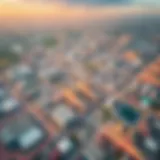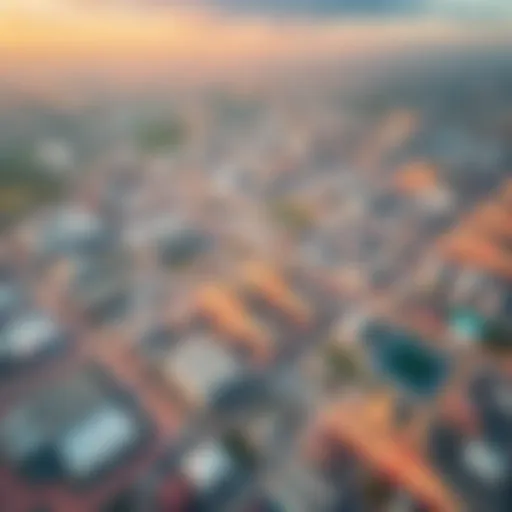Dubai's Land Use Dynamics: An Analytical Perspective
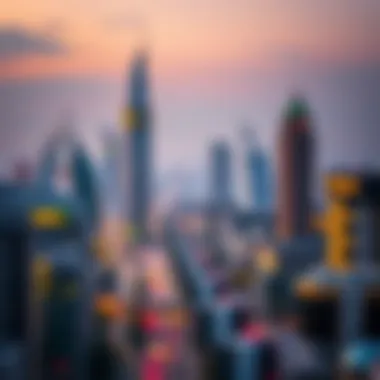

Intro
Dubai’s transformation from a modest coastal town into a global metropolis is nothing short of extraordinary. Its rapid growth, characterized by a unique blend of cultural heritage and modern innovation, lays the groundwork for a distinct spatial dynamic. The relationship between land size, urban planning, and community development plays a pivotal role in shaping the experiences of residents and visitors alike.
Understanding this intricate interplay is key, especially for homeowners, planners, and architects who navigate this ever-evolving landscape. Let’s embark on a journey through this vibrant city, exploring the different facets that contribute to its character. This analysis seeks to demystify how land usage influences neighborhood development and community life in Dubai, enriching both our insights and the quality of urban living.
Understanding Dubai's Geographic Context
Understanding the geographic context of Dubai is crucial for grasping its unique urban landscape and the factors that influence its development. The geographical features and the location of Dubai shape not only the physical space but also affect social dynamics, commercial growth, and cultural identity. By delving into this aspect, one can unravel how the interplay between land size and usage informs urban planning strategies and community living.
Geographical Location and Size
Dubai is situated on the southeastern coast of the Arabian Peninsula, bordered by the Persian Gulf to the northwest. This strategic position not only enhances its significance as a commercial hub but also places it at the crossroads of international trade routes. Covering an area of approximately 4,114 square kilometers, Dubai embodies a blend of modern architecture and traditional Islamic influences. It’s great to see that it’s not just a sprawling metropolis; there are vast stretches designed for specific purposes, whether it be residential, commercial, or recreational.
The growth trajectory of Dubai can be traced back to its initial landing of fishing villages that evolved over decades into a bustling city. Nowadays, its land size reflects both ambition and determination to carve out a niche among leading global cities.
By knowing the geographical features and the total area, we can better appreciate how Dubai maintains equilibrium between development and preserving elements of its historical essence. For instance:
- Key Locations such as the Burj Khalifa and Palm Jumeirah highlight important landmark features.
- Natural boundaries like the desert enhance the city’s allure, creating a stark contrast between the urban landscape and the native ecosystem.
The expanse of land also impacts climate management, urban design, and resource allocation, affecting everything from transportation networks to public amenities and infrastructure planning.
Climate and Topography
Dubai’s climate is characterized by scorching summers, with temperatures that can reach a sweltering 50 degrees Celsius. The city sits in an arid desert environment, surrounded by sandy dunes and the azure of the Arabian Gulf. The overall topography lacks extensive natural features, which affects how the city is planned and developed.
This hot climate leads to unique urban considerations:
- Cooling Solutions: The architecture incorporates various cooling techniques, such as shaded walkways and air-conditioned spaces, enhancing comfort for residents and visitors alike.
- Water Usage: The scarcity of natural freshwater sources necessitates innovative solutions, including desalination plants that provide water for daily needs.
Effectively, the topography and climate of Dubai not only dictate its architectural style but also influence the lifestyle of those who inhabit it. This understanding of climatic norms shapes urban policies and community designs, ensuring people adapt to, rather than resist, their environmental conditions.
To sum up, understanding Dubai's geographic context — that is, its location, land size, climate, and topography — serves as the foundation for unlocking the intricate dynamics of land usage and urban development in this vibrant city. As it continues to evolve, the insights derived from its geographic features will undoubtedly play a pivotal role in shaping its future.
Historical Overview of Land Development
The narrative of land development in Dubai offers insight into its transformative journey from a modest coastal town to a global city that sparkles like a jewel in the desert. This historical context is pivotal for understanding how current land use and urban planning have been influenced by past decisions. By tracing the steps of Dubai's land management and development strategies, we open a window to the essentials of zoning laws, cultural significance, and community identity tied to land use.
The evolution of land usage raises several critical elements:
- Understanding Foundations: Knowledge of the past provides a baseline for identifying the factors that shape current urban landscapes.
- Cultural Sensitivity: Past practices guide contemporary planners in maintaining the cultural integrity of neighborhoods.
- Adaptive Strategies: Historical context illustrates how past socio-economic events shape adaptive planning strategies.
In this section, we will navigate through two distinct eras of development: the pre-urbanization phase, where the groundwork for growth was laid, and the rapid modernization that ignited dramatic changes across the landscape.
Pre-Urbanization Era
Before the city’s meteoric rise, the area that is now Dubai was a quiet fishing village, primarily focused on pearl diving and trade. Understanding this era is crucial as it sets the stage for the societal and economic shifts that would later catalyze urban growth.
In the 19th century, the region started to emerge as a key trading post, often referred to as a crossroads for merchants from Asia, Africa, and Europe. The geographical placement along the Arabian Gulf facilitated maritime trade routes, but the early settlement was characterized by a tight-knit community, relying heavily on its natural resources for survival.
Land use during this time was simplistic, driven by necessity rather than planning. Settlers constructed narrow lanes, wind-tower houses, and marketplaces that catered to local demands. This organic growth around the creek can still be appreciated in areas like Al Fahidi Historical Neighborhood, showcasing the original architecture and layout. At this early stage, there were no expansive plots or zoning laws; land was utilized in a direct, rather unrefined manner that focused on survival and trade.
Rapid Modernization
The real shift in land development began post-1966, following the discovery of oil. This period marks a rapid transformation as the influx of financial resources allowed for ambitious urban planning projects. The Dubai government, under Sheikh Rashid bin Saeed Al Maktoum, actively pursued modernization strategies aimed at diversifying the economy beyond oil. Development plans were rolled out with impressive speed. Plans for housing, commercial businesses, and infrastructure were put in motion, leading to the establishment of a modern urban grid that dramatically shifted the community's character.
During this era, several notable landmarks were constructed, including the Dubai World Trade Centre and, eventually, the Burj Khalifa. Not only did these structures redefine the skyline, but they also indicated Dubai’s stance on global economic competition. The zoning laws were established to regulate land use more effectively, introducing residential, commercial, and mixed-use zones. The impact of these regulations can be seen in sprawling neighborhoods like Dubai Marina, where luxury and leisure intertwine.
"The rapid modernization of Dubai has turned it into a playground of the rich and famous, but the layers of its past remain etched in its dynamic urban fabric."
The effects of swift urbanization are a double-edged sword. On one hand, the economic boom and infrastructural development opened countless opportunities, reshaping Dubai into a global hub. On the other hand, it introduced challenges such as environmental stress and urban sprawl that continue to impact land management policies today.
In synthesis, the historical overview of land development in Dubai offers a roadmap to understanding its present urban environment. By delving into the pre-urbanization and modernization eras, we glean insights into the socio-economic forces and planning decisions that have propelled Dubai into international prominence, while setting the stage for future considerations in land use and community planning.
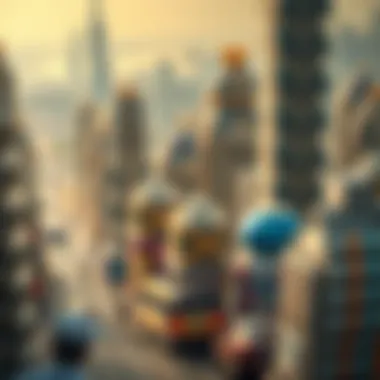

Zoning and Land Use Regulations
In the context of Dubai, zoning and land use regulations stand as a cornerstone to its intricate urban landscape. Understanding these regulations is pivotal as they shape the way cities develop, influence community dynamics, and affect the everyday lives of residents and visitors. The regulations act as a governance mechanism, showing how space is distributed and utilized, ensuring that growth does not spiral out of control nor hinder essential city livability.
Types of Zoning in Dubai
Dubai employs a meticulous zoning framework that categorizes land into specific uses, optimizing urban functionality. Here are primary zoning classifications:
- Residential Zoning: Areas designated for housing, where single-family homes, apartment buildings, and mixed-use residential developments coexist. This allows for diverse living options for a sprawling population.
- Commercial Zoning: Zones that accommodate businesses, retail spaces, and corporate offices. The bustling commercial districts like Dubai Marina and Business Bay thrive under this zoning, providing necessary services and economic opportunities.
- Industrial Zoning: These are areas designated for manufacturing, warehouses, and logistics. Situated often on the outskirts of the city, this zoning ensures that industrial activities do not intrude on residential comfort.
- Mixed-Use Zoning: A blend that allows for both residential and commercial properties. These areas promote a vibrant lifestyle where living spaces are intertwined with amenities, exemplified by the Downtown Dubai area.
The benefits of such zoning are manifold: it promotes organized growth, reduces conflicts between different land uses, and enhances the quality of urban life. However, flexibility is also crucial; as markets evolve, so too must the regulations that govern them.
Impact of Regulations on Urban Fabric
The impact of zoning regulations on Dubai's urban environment cannot be overstated. These rules dictate not just where buildings can rise, but also their height, design aesthetics, and even the density of populations. Overall, they play a role in defining how Dubai's unique urban fabric is stitched together.
For example, land use regulations have helped develop a unique skyline, with modern architectural marvels like the Burj Khalifa and Burj Al Arab having their places dictated by zoning laws. In contrast, strict regulations also ensure green spaces are preserved among the concrete jungle, giving residents areas for leisure and relaxation, such as Al Barsha Park or the community-centric Mushrif Park.
The commitment to maintaining a balance between high-density development and vibrant community spaces speaks volumes about the intent behind these regulations. They also help mitigate urban sprawl, guiding development while preserving cultural heritage and identity. Moreover, the dynamic nature of these regulations allows for adaptability to contemporary needs, fostering a growth model that retains Dubai's character even as it expands.
It is essential to understand that effective zoning is not merely a bureaucratic obstacle; it is a powerful tool that fundamentally shapes the city's character and how its inhabitants interact with their surroundings.
In summary, Dubai's zoning and land use regulations are not sets of arbitrary rules; instead, they are vital strategies aimed at managing the city's rapid growth, enhancing the quality of life for its residents, and ensuring a harmonious urban environment. As the city continues its trajectory towards being a global hub, these regulations will most likely adapt, reflecting the changing landscape of economic and social needs.
Neighborhoods and Their Distinct Land Uses
Understanding the distinct land uses within neighborhoods of Dubai is crucial, as it reveals the city’s character and functionality. The spatial organization of neighborhoods affects every resident's daily life—from where they work to where they unwind. Distinct land uses signify how diverse areas function, catering to particular aspects of the population's needs.
Unique neighborhoods in Dubai serve different purposes—some are infused with commercial vigor while others radiate residential charm. Appreciating these differences helps in recognizing the urban dynamics at play, from zoning laws that dictate land usage to how community interaction unfolds within these spaces.
Increased connectivity and accessibility in neighborhoods also influence residential choices and business opportunities, promoting a living environment that is both practical and enjoyable. Dubai's neighborhoods offer a case study on balancing distinct land use while striving for a coherent urban integration.
Commercial vs. Residential Areas
When examining Dubai, a keen distinction surfaces between commercial and residential areas. Commercial zones—such as those found in Business Bay and the Dubai International Financial Centre—are bustling hubs. They host various businesses ranging from luxury retailers to global corporations. These neighborhoods are often characterized by skyscrapers, modern infrastructure, and vibrant street life, all contributing to Dubai’s reputation as a global business center.
In contrast, residential neighborhoods such as Jumeirah and Arabian Ranches focus on providing a homey atmosphere, featuring villas, parks, and family-friendly facilities. Each residential area attracts specific demographics based on lifestyle preferences, schools, and amenities. This leads to localized cultures and identities within the diverse tapestry of the city.
"Dubai’s neighborhoods reflect a blend of cultures, where each area tells its own distinct story through its design and use of land."
Factors influencing the delineation between these areas include:
- Zoning Laws: Dictate what kind of development can occur. Mixed zoning exists, where both commercial and residential properties coexist, leading to lively and diversified neighborhoods.
- Accessibility: Residential areas need easy access to commercial sites, making transit options like the Metro crucial.
- Community Amenities: Parks, schools, and leisure areas are often prioritized in residential zones, while commercial hubs emphasize shopping and business facilities.
Mixed-Use Developments
Mixed-use developments have gained traction in Dubai, fostering a symbiotic relationship between living, working, and recreation. These spaces blur the lines between residential and commercial land uses, often leading to vibrant communities where amenities are just a stone's throw away.
Prominent examples include City Walk and Dubai Marina, where residential towers are coupled with shops, restaurants, and entertainment venues. This promotes not only convenience but also social interaction among diverse groups. The design of these developments often features pedestrian-friendly layouts, ensuring that residents and visitors can enjoy the ambiance without relying heavily on automobiles.
The emergence of mixed-use areas is notable for several reasons:
- Enhanced Urban Experience: With amenities close at hand, residents feel more connected to their communities, enhancing their overall lifestyle.
- Economic Synergy: Local businesses thrive when they are positioned near residential areas, attracting foot traffic and cultivating a sense of community vibrancy.
- Sustainable Development: Increased urban density in these areas reduces land consumption, which is pivotal in a city like Dubai where land is at a premium.
While mixed-use developments offer numerous benefits, they do come with challenges. Ensuring the right balance of residential comfort and commercial activity can be tricky, necessitating thoughtful urban planning and community engagement.
Parks and Green Spaces in Dubai
Parks and green spaces play an essential role in enhancing Dubai's urban landscape. They provide not only aesthetic value but also recreational opportunities and environmental benefits that profoundly impact the quality of life for residents and visitors. As Dubai evolves, the integration of green spaces becomes crucial for sustainable development and urban planning, reflecting the city's commitment to improving the living conditions within its bustling environment.
Significance of Green Areas
The significance of green areas in Dubai cannot be overstated. They offer a respite from the architectural grandeur of skyscrapers and urban development that dominate the skyline. Green spaces serve as lungs for the city, helping to improve air quality and providing habitats for various species that contribute to biodiversity. Moreover, these areas often foster a sense of community, acting as gathering spots where families and friends can engage in leisure activities.
Research indicates that access to parks can lead to healthier lifestyles; people are more likely to engage in physical activities such as jogging and playing sports when such areas are readily available. Furthermore, green spaces can reduce stress levels, contributing positively to mental health. As such, seamless inclusion of parks in urban designs is paramount for balanced development.
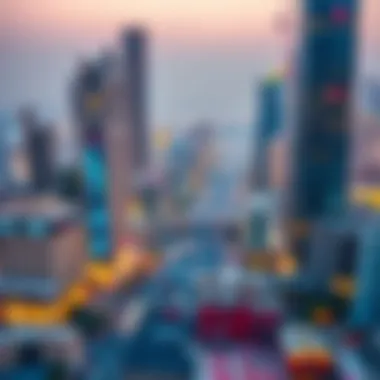

It's worth noting that parks also play a significant role in mitigating urban heat. With the harsh sun bearing down on Dubai, trees and plants absorb heat and provide shade, cooling the surrounding environment. This is particularly vital in a city where temperatures can soar above 40 degrees Celsius during the summer months.
Popular Parks and Recreational Spaces
There are several popular parks and recreational spaces throughout Dubai that exemplify the concept of integrating nature within an urban setting:
- Al Barsha Pond Park: This park features a large pond surrounded by walking and cycling tracks, making it a family favorite for picnics and outdoor activities.
- Zabeel Park: Spanning over 45 hectares, Zabeel Park offers green lawns, a children’s area, and even a tech museum. The park is an oasis in the city, balancing entertainment and tranquility.
- Dubai Miracle Garden: Home to over 50 million blooming flowers, this seasonal garden illustrates how creativity in landscaping can transform a desert environment into a vibrant tapestry of colors.
- Safa Park: Known for its picturesque lake and extensive jogging trails, Safa Park is often a hub for fitness enthusiasts and families alike.
"Green spaces are not merely an aesthetic addition; they are a fundamental aspect of urban life that nourishes physical and mental health.”
The presence of these parks reflects Dubai’s dedication to creating a harmonious balance between urban growth and environmental stewardship. With ongoing projects aiming to expand green spaces, residents can hopefuly expect a greener and healthier city in the near future.
For further information about green spaces, you can check Wikipedia or relevant local government resources.
Real Estate Trends and Development
Real estate trends and development play a pivotal role in understanding how Dubai’s urban landscape evolves and adapts to various economic, social, and environmental factors. With its relentless growth, Dubai stands as a beacon for investment, innovation, and architectural marvels. The examination of real estate trends sheds light on the intricate relationship between land size, urban population, and community engagement.
Current Market Dynamics
Dubai's real estate market has seen a significant shift in recent years. Historically dominated by high-end luxury properties characterized by extravagant developments, there is a growing demand for more affordable housing options. In the past year, prices have stabilised, providing a more balanced market for both buyers and renters. Factors influencing the current dynamics include:
- Economic Diversification: As Dubai diversifies its economy beyond oil, sectors like technology and tourism are contributing to rising demand for residential and commercial spaces.
- Infrastructural Investments: Enhanced connectivity through initiatives such as the Dubai Metro expansion not only promotes accessibility but also increases the attractiveness of peripheral neighborhoods.
- Expat Population Trends: A steady influx of expatriates continues to shape the demand patterns in Dubai’s real estate market, leading to innovations in property types and amenities designed to cater to diverse populations.
This evolving landscape remains influenced by external factors like global economic conditions and geopolitical stability, affecting investor confidence and the overall appeal of Dubai as a property destination.
Future Projections
Looking ahead, the future of Dubai's real estate market appears to be on an upward trajectory, though it is prudent to consider various pivotal trends. Analysts anticipate several key shifts shaping the development landscape in the coming years:
- Sustainability Focus: With the global emphasis on sustainable practices, developers will likely prioritize eco-friendly building designs and materials, aiming for reduced environmental impacts. The Green Building Code in Dubai serves as a framework for these efforts.
- Smart Technology Integration: The rise of smart buildings equipped with advanced technology for energy efficiency, security, and resident convenience will likely attract modern buyers. This includes features like automated systems for climate control and security.
- Urban Resilience: With climate change concerns, city planners are focusing on innovative practices to ensure that urban areas can withstand environmental challenges. Adaptation and resilience will become integral components in future developments.
In summary, the real estate market in Dubai is not merely a function of current price dynamics but a complex interplay of cultural, economic, and environmental changes. By keeping an eye on these evolving trends, homeowners, visitors, planners, and architects can better understand the nuanced landscape of real estate in this dynamic city.
Investing in Dubai’s real estate is about more than transactions; it’s about being part of a larger narrative of growth and transformation.
For further reading, consider visiting Dubai Land Department and Arabian Business Real Estate.
By examining the current dynamics and future projections, we can glean insights not only into the economic fabric of the city but also into the lifestyle changes it fosters as it continues to carve its niche in the global urban environment.
Cultural Landmarks and Community Identity
Cultural landmarks play a crucial role in shaping the identity of a community, particularly in a dynamic city like Dubai. They are not merely structures of stone and steel; these sites reflect the past, present, and future aspirations of the city's diverse population. Each landmark tells a story, contributing to the rich tapestry of cultural heritage, while also serving practical functions in urban life. Such spaces foster a sense of belonging among residents and provide visitors with insight into the local way of life.
Historical Structures and Their Context
Dubai is peppered with historical structures that have significant meaning. For instance, the Al Fahidi Historic District, previously known as Al Bastakiya, showcases traditional Emirati architecture, with its narrow lanes and wind-tower houses giving a glimpse into life before the glittering skyline dominated. This juxtaposition of the old and the new accentuates the city’s rapid transformation while preserving a sense of history.
Another significant landmark is the Dubai Museum located in the Al Fahidi Fort. It educates visitors about the emirate’s rich history and culture, taking them on a journey through time.
"Cultural landmarks are the lenses through which communities see themselves and their narratives."
Such locations not only represent architectural prowess but also serve as venues for community events, art exhibitions, and cultural performances. This engenders a shared cultural identity that can be enjoyed by all, from locals to tourists.
Influence of Culture on Land Utilization
The way land is utilized in Dubai reflects its cultural values and societal norms. The traditional souks, or markets, like the Gold Souk and Spice Souk, not only serve commercial purposes but also act as social hubs where people gather. These spaces are designed to be vibrant and interactive, encouraging community engagement and a lively atmosphere.
Moreover, religious and cultural sites, such as the Jumeirah Mosque, play essential roles in the community, drawing visitors and fostering inter-community dialogues. These landmarks are integrated into the urban fabric, guiding the design of nearby public spaces, enhancing accessibility, and setting the tone for surrounding developments.
In essence, cultural considerations are at the forefront of urban planning in Dubai. This thoughtful integration creates a harmonious balance between modernity and tradition, providing a guide for future urban utilization strategies.
The cultural landmarks of Dubai are not just locations; they are integral to building community identity and cohesion. The narratives they encapsulate remind individuals of their heritage while inviting engagement from a global audience. This interaction is vital for any city aiming to preserve its unique character in an era of globalization.
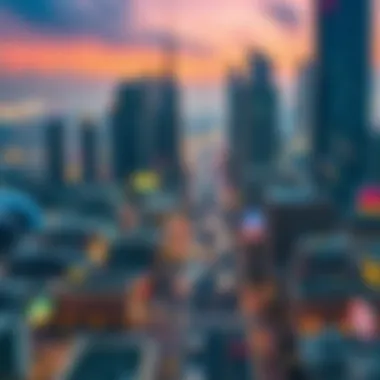

Challenges in Land Management
Effective land management in Dubai is crucial when navigating the complexities of urban growth, environmental issues, and the socio-economic factors at play. As a city that has expanded from a small fishing village to a dazzling metropolis, the challenges in managing land create ripples that affect many areas, such as sustainable development, community identity, and urban planning. This section delves into several specific challenges, including environmental concerns and the implications of urban sprawl.
Environmental Concerns
The environmental implications associated with Dubai’s rapid urbanization are a weighty topic. With developments stretching across the Emirate, the balance between expansion and conservation is constantly tested. Land degradation, habitat loss, and increased pollution levels raise serious alarms. Some key environmental issues include:
- Water Scarcity: The arid climate poses significant threats to water resources, necessitating the reliance on desalination, which itself consumes extensive energy resources.
- Biodiversity Loss: As new constructions arise, unique ecosystems and native species often face threats. Marine life, in particular, suffers from habitat destruction as coastal developments proliferate.
- Waste Management: The sheer volume of construction waste and urban refuse creates a pressing need for improved waste management systems, impacting the surrounding environment and community health.
"Navigating the narrow line between modern conveniences and environmental preservation is akin to walking the tightrope; a single misstep could send the entire balance spiraling."
To address these concerns, planners must integrate green spaces and efficient public transport into their designs. Initiatives promoting recycling and renewable energy sources can also mitigate some adverse impacts, making thoughtful land management an essential practice.
Urban Sprawl and Its Effects
Dubai's skyline is a breathtaking display of architectural wonders, but the rapid expansion of its urban footprint raises several critical concerns associated with urban sprawl. Here are some of the notable effects of this phenomenon:
- Traffic Congestion: As neighborhoods expand without coherent transport planning, residents increasingly rely on personal vehicles. This has not only raised traffic congestion but also compounded air pollution issues, impacting health and quality of life.
- Social Isolation: Urban sprawl can isolate communities when developments are not interconnected. Residents may end up living in bubble-like neighborhoods, with little access to shared spaces or community engagement.
- Infrastructure Strain: The demands on infrastructure—like roads, utilities, and social services—intensify as urban areas extend outwards. This can lead to service delivery issues, where some areas do not receive adequate support compared to rapidly growing localities.
To remedy these challenges, innovative urban planning strategies must be employed, focusing on mixed-use developments that create vibrant, livable communities. Incorporating smart city initiatives could also enhance the efficiency of urban spaces, ensuring a balanced growth model that preserves both land and community integrity.
In summary, addressing these challenges in land management is pivotal for Dubai's sustainable development. Ensuring that growth meets modern expectations while safeguarding the environment is not just a goal—it’s a necessity.
Innovative Urban Planning Strategies
Innovative urban planning strategies are vital to the sustainable development and efficient management of spaces in a rapidly evolving city like Dubai. The city's economic growth, coupled with its diverse population and unique climatic conditions, demands a thoughtful approach to urban planning that incorporates not only residential and commercial needs but also considers environmental impacts and community well-being.
Smart City Initiatives
Dubai has invested heavily in smart city initiatives, aiming to make urban infrastructure more efficient, connected, and adaptable. These initiatives primarily utilize advanced technologies to improve the quality of life for citizens and visitors alike. Notably, the Dubai Smart City project integrates information and communication technologies (ICT) across various sectors.
Key Features of Smart City Initiatives:
- Connected Infrastructure: Through internet-connected sensors and devices, the city can gather real-time data. This approach is used to address traffic congestion, reduce energy usage, and enhance public safety.
- Public Services Access: Applications facilitating easy access to public services—such as transportation scheduling and utility management—enhance efficiency and user experience. These services are crucial in a city that serves millions of tourists annually.
“Smart cities harness technology to create responsive urban environments that foster improved quality of life.”
- Citizen Engagement: The incorporation of platforms that allow residents to voice their opinions and engage with governmental bodies promotes democratic decision-making, ensuring that the community feels involved in the planning processes.
Dubai's commitment to smart city principles highlights the potential to improve urban living through technology, even in a city that is already sprawling and densely populated.
Sustainable Development Practices
As the world faces mounting environmental challenges, Dubai's approach to sustainable development must balance growth with ecological considerations. The city recognizes that sustainable practices can lead to long-term benefits, both environmentally and economically.
Principles of Sustainable Development:
- Green Building Standards: Promoting building practices that adhere to sustainability criteria, such as the use of local materials and energy-efficient technology, helps in minimizing carbon footprint. Projects like the Dubai Design District exemplify these practices.
- Renewable Energy Integration: Initiatives like the Mohammed bin Rashid Al Maktoum Solar Park, which is one of the largest solar parks in the world, embody Dubai's commitment to reducing reliance on fossil fuels.
- Water Conservation: With water scarcity being a pressing issue, Dubai invests in technologies that promote water reuse and rainwater harvesting. These practices ensure that the city can sustain its rapid growth without depleting vital resources.
In summary, innovative urban planning strategies—especially through smart city initiatives and sustainable development practices—are essential in shaping Dubai's urban future. By focusing on efficiency, environmental responsibility, and community involvement, Dubai can not only maintain its remarkable growth but also create a more livable and sustainable urban environment for generations to come.
Epilogue and Future Outlook
The exploration of Dubai's land size and usage provides not only a glimpse into its geographical dynamics but also serves as a blueprint for understanding the intricate balance between urban expansion and ecological preservation. As urbanization continues to drive the demand for land, Dubai stands as a case study in both the potential and the pitfalls of rapid development. This concluding section aims to encapsulate the essence of the prior discussions while focusing on the implications for the future of this vibrant city.
Greater awareness of land management strategies, paired with innovative urban planning, can foster a more sustainable pathway for growth. As a melting pot of cultures and ideas, Dubai must strive to preserve its unique identity amid the rush for modernization. Recognizing and addressing the environmental and social challenges related to land use can lead to a more resilient urban framework. This perspective is crucial for homeowners looking to invest ethically as well as for planners aiming to create spaces that reflect the community’s heritage and aspirations.
Summary of Key Insights
- Geographical Dynamics: Dubai's strategic location and climate have shaped its development trajectory, influencing both land use and community structures.
- Land Acquisition and Zoning: Historical practices around land acquisition led to the emergence of diverse neighborhoods, each with their own unique characteristics.
- Environmental Impact: Urban sprawl poses significant risks, necessitating a focus on sustainable practices to preserve the environment while accommodating growth.
- Innovative Practices: The adoption of smart city initiatives presents opportunities to enhance efficiency and livability, marking a step toward modernization without compromising integrity.
"In the race for development, the true winner will be the city that harmonizes growth with sustainability, creating spaces where both people and nature thrive."
The Future of Dubai’s Urban Landscape
Looking forward, Dubai’s urban landscape is at a crossroads. The city has immense potential to innovate in how it utilizes land, catering to an ever-diversifying population while also addressing the pressing issues of sustainability. There is an ongoing call for adaptive spaces that blend residential, commercial, and recreational areas seamlessly.
The future might see vertical gardens sprouting on balconies and rooftops, enhancing the aesthetic while also providing ecological benefits. Furthermore, investments in public transport and pedestrian-friendly spaces will likely encourage a shift towards reduced car dependency. Ultimately, this balancing act will determine the livability of the city and the satisfaction of its inhabitants.
As urban planners and architects work collaboratively, they have the chance to redefine what urban life in Dubai can look like. By prioritizing community input and carefully considering the ecological footprint of new developments, Dubai can set an example for cities worldwide. Returning to the essence of what makes a place livable will be pivotal in steering Dubai towards a sustainable and prosperous future.










